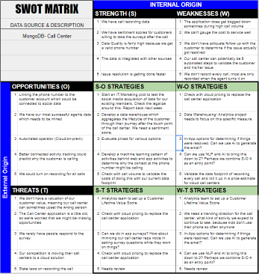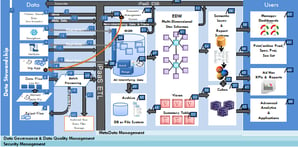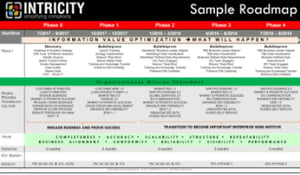
Intricity Data Moat Strategy
Written by Intricity
AI is by nature somewhat of a black box, because the model is not directly programmed, but rather learned. This means a lot of companies that attempt to roll out AI find themselves unprepared to take that step, and they thus waste a lot of time & money. So laying out the foundations where AI can succeed is a crucial first step. Today, there are two ways in which this foundation is established:
|
Simulation A simulation provides a place where AI can gather data. The programmer provides the inputs or “levers” which the AI can pull to impact its environment in the simulation. By allowing the AI to repeat the simulation and providing the AI a goal, it can create a learning model on how to optimize the inputs to reach that goal. |
Data Data is the result set of a “real world” event which can be given to AI. There are two types of data for AI, input data (levers), and output data (results). AI leverages data to discover connections between inputs and outputs, optimize the real world inputs, and provide gateways for situational nuance between the inputs and outputs. |
Intricity’s Data Moat Strategy is designed to leverage existing data foundations within organizations. These foundations are an asset that most organizations have been investing in, but often have not recognized as a strategic competitive differentiator.  Thus many organizations have not invested the time to create a centralized Data Moat. The name Data Moat is drawn from a Warren Buffett reference, “In business, I look for economic castles protected by unbreachable ‘moats’.” A data moat is a set of data that can act as an AI asset which is difficult for competitors to replicate, and thus becomes core market differentiator.
Thus many organizations have not invested the time to create a centralized Data Moat. The name Data Moat is drawn from a Warren Buffett reference, “In business, I look for economic castles protected by unbreachable ‘moats’.” A data moat is a set of data that can act as an AI asset which is difficult for competitors to replicate, and thus becomes core market differentiator.
How Does the Data Moat Strategy Get Implemented?
The Data Moat starts with a strategic data source review where Intricity facilitates sessions with your Business and Technical Stakeholders to create a SWOT Matrix for the most strategic data stores. This is conducted in an engagement which is comprised of a series of facilitated interviews with your business and technical stakeholders to identify the critical sources of data and their unique impact. From these interviews Intricity produces a series of deliverables which help focus the organization on its strategic data differentiators and how to leverage them.
Identified Data Moat(s) from SWOT Matrices
Matrices
After reviewing each source system with both the Technical and Business Stakeholders, Intricity presents an Executive Strategy of the Data Moat potential inside the organization. This presentation reviews both defensive and offensive opportunities. Additionally, Intricity identifies input and output data which can be leveraged for training AI.
Logical Solution Architecture

This is an illustration of your future landscape which contains the core components which will ensure that the data and its logic is retained in the most future viable state available, while servicing the needs of delivering effective input/output results.
Strategic Roadmap

The Logical Solution Architecture and the identified Data Moat(s) lead to the production of a strategic roadmap which defines the steps your organization must move through to deploy the Data Moat(s). Intricity phases the stages with priced estimates for each phase.
Pricing
The Intricity team is comprised of 3 members, a Solution Architect, a Data Engineer, and a Technical Business Analyst. The pricing for the Intricity Data Moat Strategy is dependent on the number of stakeholders to be interviewed. If you would like to schedule some time to discuss what the Data Moat Strategy might look like for your organization send an email to specialist@intricity.com
Who is Intricity?
Intricity is a specialized selection of over 100 Data Management Professionals, with offices located across the USA and Headquarters in New York City. Our team of experts has implemented in a variety of Industries including, Healthcare, Insurance, Manufacturing, Financial Services, Media, Pharmaceutical, Retail, and others. Intricity is uniquely positioned as a partner to the business that deeply understands what makes the data tick. This joint knowledge and acumen has positioned Intricity to beat out its Big 4 competitors time and time again. Intricity’s area of expertise spans the entirety of the information lifecycle. This means when you’re problem involves data; Intricity will be a trusted partner. Intricity's services cover a broad range of data-to-information engineering needs:
What Makes Intricity Different?
While Intricity conducts highly intricate and complex data management projects, Intricity is first a foremost a Business User Centric consulting company. Our internal slogan is to Simplify Complexity. This means that we take complex data management challenges and not only make them understandable to the business but also make them easier to operate. Intricity does this through using tools and techniques that are familiar to business people but adapted for IT content.
Thought Leadership
Intricity authors a highly sought after Data Management Video Series targeted towards Business Stakeholders at https://www.intricity.com/videos. These videos are used in universities across the world. Here is a small set of universities leveraging Intricity’s videos as a teaching tool:

Talk With a Specialist
If you would like to talk with an Intricity Specialist about your particular scenario, don’t hesitate to reach out to us. You can write us an email: specialist@intricity.com
(C) 2023 by Intricity, LLC
This content is the sole property of Intricity LLC. No reproduction can be made without Intricity's explicit consent.
Intricity, LLC. 244 Fifth Avenue Suite 2026 New York, NY 10001
Phone: 212.461.1100 • Fax: 212.461.1110 • Website: www.intricity.com

